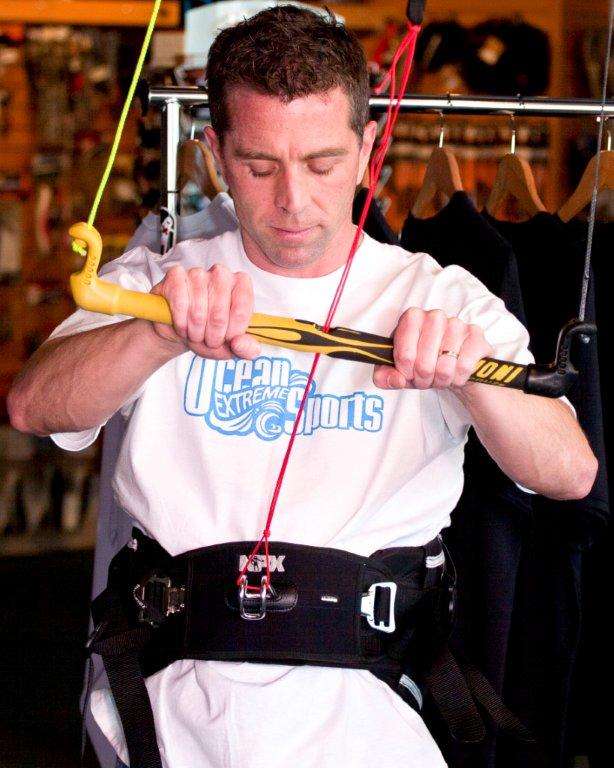For the best reading experience, click on the View in fullscreen button below.
[issuu layout=http%3A%2F%2Fskin.issuu.com%2Fv%2Flight%2Flayout.xml showflipbtn=true pagenumber=72 documentid=110425160936-64c11cc902a7446ca21de739ed28c866 docname=the-kiteboarder-april-2011 username=The-Kiteboarder-Magazine loadinginfotext=The%20Kiteboarder%20Magazine%20April%202011 width=600 height=391 unit=px]
Ghetto Kite Fixes
By Brian Miller/Ocean Extreme Sports
Have you ever been on a long downwinder and have something break? Ever been on a kite vacation where the nearest shop is hundreds of miles away? Sometimes gear breaks and you just don’t have the resources to fix it the right way. Here are a few quick fixes to get you back on the water, or at least to get you to where you need to go.
Before we start here are two very important tips:
- Keep a piece of spare line tucked into your harness somewhere. A piece of spectra about 2 – 3 feet long will do the trick. This piece of line can be used in many ways and can save your session!
- Learn to tie a bowline. Be able to tie one in your sleep. It is a kiteboarder’s best friend! There are countless resources online outlining how it can be done so I won’t bother explaining it here. Simply Google “bowline” to learn how it’s done.
Break your chicken loop or center line?
 No sweat! OK maybe a little sweat, but here’s what to do. Disassemble the chicken loop/center line and take out your trusty spare line.
No sweat! OK maybe a little sweat, but here’s what to do. Disassemble the chicken loop/center line and take out your trusty spare line.
- Tie a bowline on one end of the spare line with a loop big enough to fit around your spreader bar hook.
- Now tie the other end of the spare line to your depower strap, making sure the overall length is as close as possible to the original length of your center line.
- If you have a thicker piece of spectra as a spare, a quick and effective method is to tie a simple overhand knot near the end of the line. Next loop it through the depower strap and tie a regular overhand knot. The first knot near the end of the line will keep it from sliding out. This method is much easier and more efficient than tying a bowline if your spare line is barely long enough.
Be aware that you DO NOT have a safety release with this set up. Only do this as a last resort as it’s merely a way to get you home. It’s dangerous. It’s ghetto.
Aw Snap! Broke a line!
Breaking a line is for sure a session killer but there is one quick trick if you really need to get to where you’re going. No kite line is 100% of its original strength once it has been compromised but this method can be as close as 90%.
- Tie an overhand knot about one centimeter from the broken area on each piece.
- Tie the two pieces together using a square knot (once again, look online to see how).
- Pull the two tightly together making sure all knots are clean. Voila!
If the broken line is one of your front lines, swap it out with a rear line if possible. Your front lines take much more load than your rear lines. Do this as an added safety precaution. Also keep in mind the repaired line can be up to an inch shorter than its counterparts so adjust accordingly if possible!

Pssst… Your Kite is Leaking!
Got a hole in one of your bladders? Find a roll of packing tape! These days there are several bladder patch kits that work very well, but if you don’t have access to any of those kits a piece of packing tape will work for the short term. Make sure you clean the area around the hole before you stick the tape. Also, when a bladder pops it often blows at the end of the bladder. If that happens, pull it out, tie a knot in the very end of the bladder, and stick it back in.
Broken Pigtail
Really, how often do pigtails break? You would be surprised. When it happens, break out that piece of spare line you have stashed in your harness and make a new one. Double over the line and tie an overhand knot at the appropriate length. Don’t worry about the excess, let it hang. It’s ghetto remember?
Remember: Most quick fixes in kiteboarding are ghetto. Only use these if absolutely necessary. If you do choose to fix your gear with one of the methods described here, you do so at your own risk. Always try to carry spare parts, line sets, bladder patches, spare line, tools, and most of all learn to tie that bowline!


